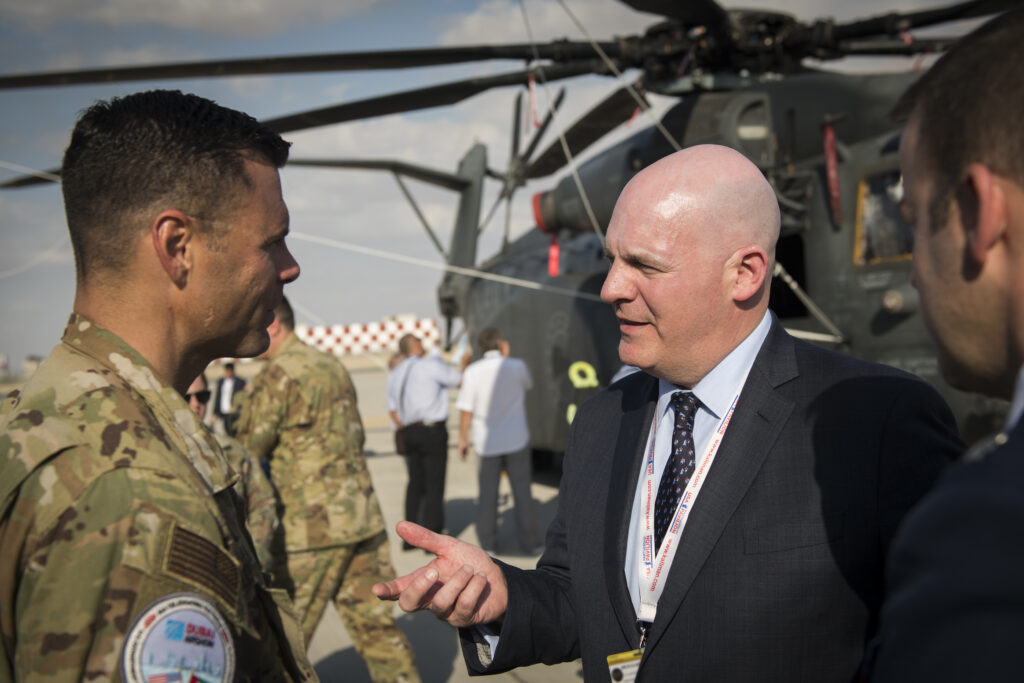
R. Clarke Cooper, left, Assistant Secretary of State for Political-Military Affairs, at the Dubai Air Show.
WASHINGTON: Days after the Trump administration notified Congress of a potential $2.4 billion sale of Harpoon missiles to Taiwan, a top State Department official said security of the island nation “is central to stability in the Indo-Pacific region.”
The deal’s unveiling came on the heels of other weapons sales slated for Taiwan worth about $1.8 billion earlier in the month, as the Trump administration rolls out a wider plan to convince all US allies and partners across the globe to spend at least 2% of their GDP on defense, a lofty metric even the wealthy countries of NATO struggle to reach.
The Harpoon announcement prompted a quick rebuke from China, which announced sanctions on a bevy of US defense companies, including Lockheed Martin, Boeing and Raytheon.
The Trump administration’s efforts to bolster Taiwan’s defense against any potential Chinese invasion or aggression is a key part of the renewed focus on drawing regional allies closer to Washington’s orbit.
Speaking with reporters during a virtual Q&A today, R. Clarke Cooper, assistant Secretary of State for political-military affairs, maintained that despite Chinese protests over the sales to Taiwan, the island’s leaders are not looking for a fight.
“If anything, the provocations are coming from Beijing. The bullying behavior…is not with Taiwan [which is] maintaining its own self defense.”
The Trump administration has entered into a variety of agreements recently to boost allies and try to bottle Chinese ambitions, including sharing geospatial intelligence with India and potentially establishing a new base on the island of Palau to provide new airfields and ports for Navy ships in the Philippine Sea.
“We are making sure that Taiwan is not bullied or are overcome by Beijing,” Cooper said. “So we’re looking at this from not just from a self-defense aspect, but also stability,” in the region.
Part of the US strategy in the region is to coax allies into spending more on their own defense.
Recently, Defense Secretary Mark Esper and National Security Advisor Robert O’Brien suggested that the new “gold standard” for allies across the globe is to spend 2% of their GDP on defense.
The goal has been a part of NATO planning since 2014. Only a handful of nations have reached the threshold, which has rankled President Trump since he took office. That anger boiled over during a messy blowup at a July 2018 NATO meeting in Brussels where he threatened to leave the alliance.
Earlier this month, Esper called the 2% goal “the floor” of what the administration expects from all allies. “We expect all allies to invest more in defense, at least 2 percent of GDP,” he said.
“We expect them to stand shoulder to shoulder with the United States in confronting Chinese bad behavior and Russian aggression,” Esper said at the Atlantic Council. “To overcome the increasingly complex threats in the 21st century and defend our shared values, there can be no free riders to our common security.”
The defense secretary’s comments on Oct. 20 came just days after O’Brien said Taiwan is “getting closer to 2 percent, which would be a NATO level — obviously Taiwan’s not part of NATO, but that would be kind of a benchmark — and they probably need to go beyond that given the buildup of Chinese forces especially across the Taiwan Strait.”
O’Brien later called the 2% goal “the gold standard, and countries, even non-NATO countries, want to hit it.”
Two percent of a nation’s GDP pumped into defense has always been something of an arbitrary goal, and it represents is a level of spending that only a small fraction of countries anywhere on the planet can, or wish to, reach. While the US spent about 3.4% of its GDP on defense in 2019, many other close allies — both in and out of NATO — don’t come close. According to the World Bank, Australia spends about 1.9%, the UK 1.7%, Japan 0.9%, and Taiwan is 1.7%. Only 10 of the 29 NATO countries hit the mark, but that’s up from five in 2016.
I asked Cooper about the recent push for 2% globally and what that might mean for allies outside NATO. He took a wide view, avoiding a direct answer while making the broader point that allied defense spending is part of broader security relationships the US shares with partners.
“We certainly want to make sure from a readiness and capability standpoint, that they’re able to be guarantors of their own sovereignty,” he said. “What this is an emphasis on, is the investment in their sovereign space, so that they can be a better security cooperation partner, regardless of the state.”
Iran says it shot down Israel’s attack. Here’s what air defense systems it might have used.
Tehran has been increasingly public about its air defense capabilities, including showing off models of systems at a recent international defense expo.


























